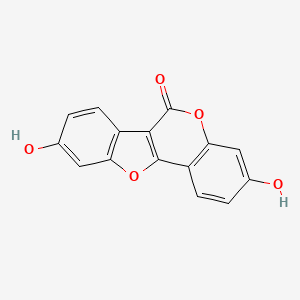| MeSH term | MeSH ID | Detail |
|---|---|---|
| Breast Neoplasms | D001943 | 24 associated lipids |
| Lupus Erythematosus, Systemic | D008180 | 43 associated lipids |
| Pancreatic Neoplasms | D010190 | 77 associated lipids |
| Colonic Neoplasms | D003110 | 161 associated lipids |
| Mammary Neoplasms, Experimental | D008325 | 67 associated lipids |
| Body Weight | D001835 | 333 associated lipids |
| Edema | D004487 | 152 associated lipids |
| Weight Gain | D015430 | 101 associated lipids |
| Endometriosis | D004715 | 29 associated lipids |
| Birth Weight | D001724 | 23 associated lipids |
COUMESTROL
COUMESTROL is a lipid of Polyketides (PK) class. Coumestrol is associated with abnormalities such as Infertility, Renal tubular disorder, Osteoporosis, Postmenopausal, Nodule and Central precocious puberty. The involved functions are known as Process, antagonists, Accident due to exposure to weather conditions, physiological aspects and Cell Proliferation. Coumestrol often locates in Blood, Body tissue, Reproductive system, Membrane and Myometrial. The associated genes with COUMESTROL are GAPDH gene, PPID gene, pyridinoline, NODAL gene and Nitrogen fixation gene. The related lipids are enterodiol. The related experimental models are Mouse Model.
Cross Reference
Introduction
To understand associated biological information of COUMESTROL, we collected biological information of abnormalities, associated pathways, cellular/molecular locations, biological functions, related genes/proteins, lipids and common seen animal/experimental models with organized paragraphs from literatures.
What diseases are associated with COUMESTROL?
COUMESTROL is suspected in Infertility, Renal tubular disorder, Osteoporosis, Postmenopausal, Nodule, Central precocious puberty and other diseases in descending order of the highest number of associated sentences.
Related references are mostly published in these journals:
| Disease | Cross reference | Weighted score | Related literature |
|---|
Possible diseases from mapped MeSH terms on references
We collected disease MeSH terms mapped to the references associated with COUMESTROL
PubChem Associated disorders and diseases
What pathways are associated with COUMESTROL
There are no associated biomedical information in the current reference collection.
PubChem Biomolecular Interactions and Pathways
Link to PubChem Biomolecular Interactions and PathwaysWhat cellular locations are associated with COUMESTROL?
Visualization in cellular structure
Associated locations are in red color. Not associated locations are in black.
Related references are published most in these journals:
| Location | Cross reference | Weighted score | Related literatures |
|---|
What functions are associated with COUMESTROL?
Related references are published most in these journals:
| Function | Cross reference | Weighted score | Related literatures |
|---|
What lipids are associated with COUMESTROL?
Related references are published most in these journals:
| Lipid concept | Cross reference | Weighted score | Related literatures |
|---|
What genes are associated with COUMESTROL?
Related references are published most in these journals:
| Gene | Cross reference | Weighted score | Related literatures |
|---|
What common seen animal models are associated with COUMESTROL?
Mouse Model
Mouse Model are used in the study 'Modulation of tumor formation and intestinal cell migration by estrogens in the Apc(Min/+) mouse model of colorectal cancer.' (Javid SH et al., 2005).
Related references are published most in these journals:
| Model | Cross reference | Weighted score | Related literatures |
|---|
NCBI Entrez Crosslinks
All references with COUMESTROL
Download all related citations| Authors | Title | Published | Journal | PubMed Link |
|---|---|---|---|---|
| Degen GH et al. | Estrogenic isoflavones in rodent diets. | 2002 | Toxicol. Lett. | pmid:11869825 |
| Foster WG et al. | Detection of phytoestrogens in samples of second trimester human amniotic fluid. | 2002 | Toxicol. Lett. | pmid:11888703 |
| Jacquot Y et al. | Pharmacological profile of 6,12-dihydro-3-methoxy-1-benzopyrano[3,4-b] [1,4]benzothiazin-6-one, a novel human estrogen receptor agonist. | 2002 | Biol. Pharm. Bull. | pmid:11913529 |
| Pocock VJ et al. | Comparison of the oestrogenic effects of infant milk formulae, oestradiol and the phytoestrogen coumestrol delivered continuously in the drinking water to ovariectomised mice. | 2002 | Food Chem. Toxicol. | pmid:11955670 |
| Jacquot Y et al. | Synthesis and cytotoxic activity of new 2,4-diaryl-4H,5H-pyrano[3,2-c]benzopyran-5-ones on MCF-7 cells. | 2002 | Pharmazie | pmid:11998440 |
| Szkudelska K et al. | Daidzein, coumestrol and zearalenone affect lipogenesis and lipolysis in rat adipocytes. | 2002 | Phytomedicine | pmid:12120815 |
| Knuckles BE et al. | Coumestrol content of fractions obtained during wet processing of alfalfa. | 1976 Nov-Dec | J. Agric. Food Chem. | pmid:12201 |
| Han DH et al. | Relationship between estrogen receptor-binding and estrogenic activities of environmental estrogens and suppression by flavonoids. | 2002 | Biosci. Biotechnol. Biochem. | pmid:12224631 |
| Jefferson WN et al. | Assessing estrogenic activity of phytochemicals using transcriptional activation and immature mouse uterotrophic responses. | 2002 | J. Chromatogr. B Analyt. Technol. Biomed. Life Sci. | pmid:12270211 |
| Papaconstantinou AD et al. | Increases in mouse uterine heat shock protein levels are a sensitive and specific response to uterotrophic agents. | 2002 | Environ. Health Perspect. | pmid:12460799 |
